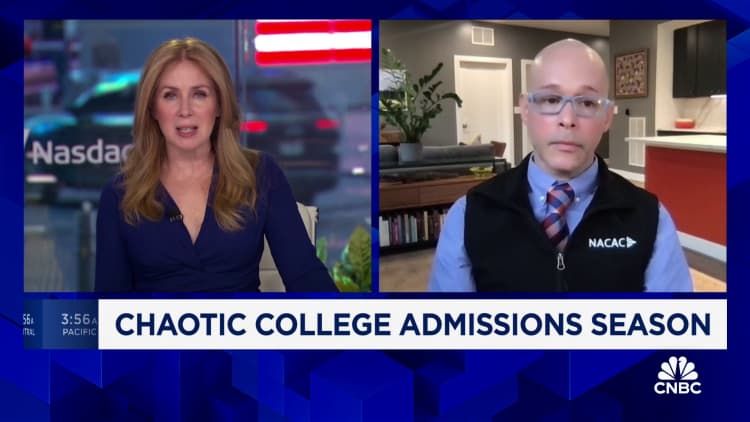Immigration and Customs Enforcement agents detain a man after conducting a raid at the Cedar Run apartment complex in Denver, Colorado, U.S., Feb. 5, 2025.
Kevin Mohatt | Reuters
A spate of federal immigration enforcement raids from Los Angeles to New York has sparked demonstrations and rallies around the country, leading to mass arrests and National Guard deployment.
The U.S. Immigration and Customs Enforcement crackdown has heightened concerns of foreign-born residents, especially undocumented immigrants and their families, about how they should prepare for worst-case scenarios of being detained or deported.
Planning ahead for such emergency scenarios must include a strategy for who will handle their finances and how, experts say.
“When people are detained or deported without having legally designated somebody to manage their assets, they might lose access to their accounts or their property,” said Sarah Pacilio, a director at the Appleseed Network, a nonprofit network of justice centers in the U.S. and Mexico.
Managing financial matters from abroad can be challenging due to limited access to bank accounts or service providers, she said.
Here’s a look at more stories on how to manage, grow and protect your money for the years ahead.
Make a plan for a worst-case scenario
Having a plan is crucial. The Appleseed Network has published a detailed “Deportation Preparation Manual for Immigrant Families,” which is available for free on its website. There are also financial planners who offer their services for free to families in need, through groups including the Financial Planning Association and the Foundation for Financial Planning.
“Right now, there’s a lot of fear, there’s a lot of trauma,” said certified financial planner Louis Barajas, CEO of International Private Wealth Advisors.
“I want to give people information so they can at least take some power back,” said Barajas, whose firm is based in Orange County, California, and who does pro bono work with Santa Ana’s predominantly Latino community.
To protect assets — including homes, bank accounts and retirement savings — financial and legal experts recommend taking these key steps:
Collect and secure key documents
Collect and make copies of important documents, including birth certificates, immigration paperwork, other forms of identification and work permits.
Make a list of bank and credit card accounts, loans, leases, contracts, property and any assets in your children’s names. Include contact information for the banks, lenders and other companies involved with those accounts.
Store these records and documents in a safe deposit box at a bank or a fireproof, waterproof box or safe. Digitize the documents, too, with password-protected cloud storage or encrypted flash drives.
Taking this step can help ensure you have key details about accounts and assets wherever you are, and that physical documents are in one safe location for a trusted family member to access.
Check access to accounts
Contact your financial service providers to understand your options and rights. Pacilio recommends reaching out to your banks and lenders to determine if you can list a foreign address on your account, add someone to your account or continue using those accounts outside the U.S.
“Know what those options are in advance so that you can adequately prepare for them, and that helps to avoid surprise in a crisis situation,” she said.
Establish a power of attorney
Have legal documents in place, especially a financial power of attorney, or POA. Designating a POA also creates a back-up plan, Barajas said, so that “someone they trust can manage their finances if they are out of the country.”
A POA can also give the person you designate the authority to sign checks from your bank account, make decisions about your child’s schooling and health care, or use your money to buy or sell major items such as a car, according to the Appleseed Network.
Protect finances for future generations
Work with a legal expert to draft a pre-need guardianship document. Naming a guardian for your child in a legal document will allow an adult of your choice to step in if you are no longer able to care for the child, say, if you are deported and your child remains in the U.S., said Barajas, who is also a member of the CNBC Financial Advisor Council.
Consider buying a term life insurance policy, which can provide benefits to your loved ones if you die. Already have one? Carefully review your beneficiaries.
Create an estate plan. Consider setting up a trust to transfer assets such as real estate, non-retirement savings and life insurance proceeds, Barajas said.
“A lot of single mothers who have been deported do have insurance,” he said. “Because they’re they’re single mothers, they have named their minor children as beneficiaries on their life insurance policies — and that’s a major mistake.”
Insurers won’t give proceeds directly to minors, he said.
“That’s why I’d like them to get an estate plan done so they can name a trust as a beneficiary,” he said. “So if something were to happen to them, someone can manage that money for their children.”
SIGN UP: Money 101 is an 8-week learning course on financial freedom, delivered weekly to your inbox. Sign up here. It is also available in Spanish.


 Economics1 week ago
Economics1 week ago
 Economics1 week ago
Economics1 week ago
 Economics1 week ago
Economics1 week ago
 Finance1 week ago
Finance1 week ago
 Blog Post1 week ago
Blog Post1 week ago
 Economics1 week ago
Economics1 week ago
 Personal Finance1 week ago
Personal Finance1 week ago
 Accounting7 days ago
Accounting7 days ago













